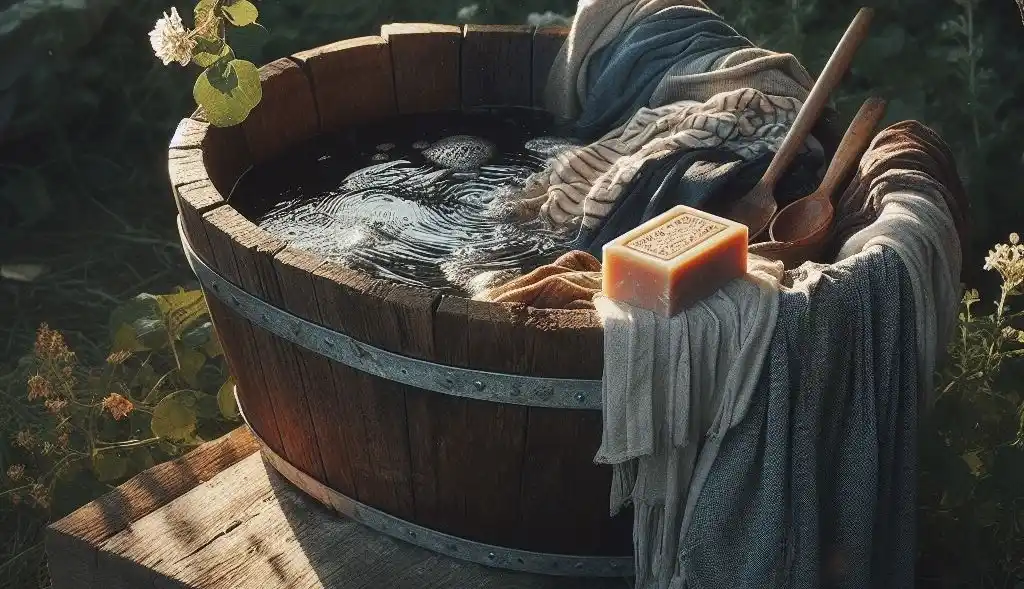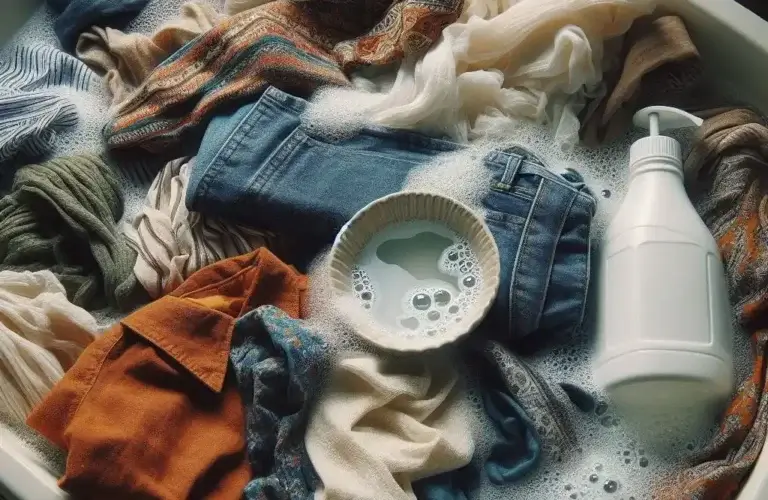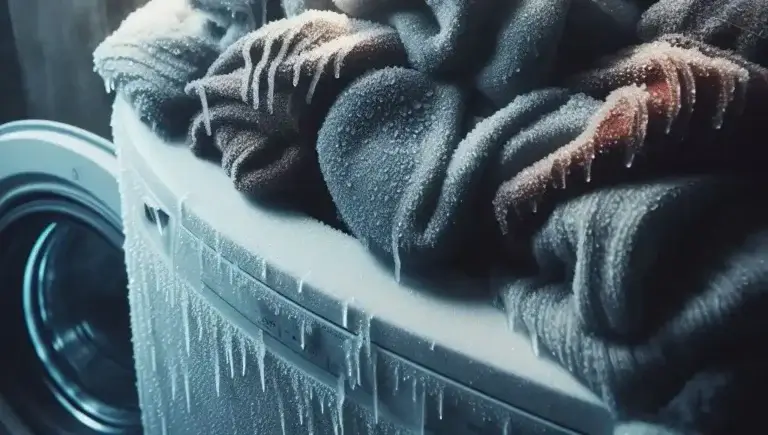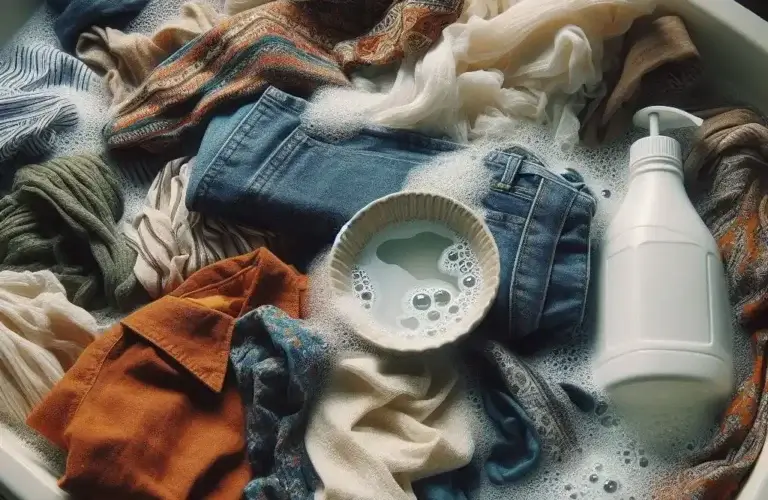How to Hand Wash Clothes Without Detergent: Laundry Detergent Alternatives
Are you looking for an effective way to hand wash your clothes when you’ve run out of laundry detergent? Hand washing clothes without detergent may seem challenging, but with some simple ingredients from around your home, you can easily get your clothes clean without harsh chemicals.
In this comprehensive guide, you’ll learn how to hand wash clothes without detergent, including:
- Why you may need to hand wash clothes without detergent
- The best detergent substitutes for hand-washing clothes
- Step-by-step instructions for hand washing clothes without detergent
- Special tips for stain removal and washing delicate fabrics
- Common mistakes to avoid when hand washing clothes
So if you’ve ever wondered if it’s possible to get your clothes clean without store-bought detergent, you’re in the right place! Let’s get started.
Table of Contents
Why Hand Wash Clothes Without Laundry Detergent?
There are a few reasons why you may need to hand wash your clothes without using regular liquid or powder detergent:
- You’ve run out – If you suddenly realize you’re out of laundry detergent when you have a load of dirty clothes, hand washing with a detergent substitute lets you clean them rather than waiting until you can get to the store.
- Skin sensitivities – Some people find that commercial laundry detergents contain irritating fragrances, dyes, and chemicals that can worsen conditions like eczema. Hand washing with gentle cleaners may be better tolerated.
- You have a high-efficiency washer – HE washers use less water and specially formulated low-sud detergents. Using a regular detergent can cause oversudsing issues and machine damage over time.
- Cleaning delicates – Bras, swimsuit fabrics, silks, and woolens clean best when hand-washed to prevent snags, shrinkage, and dye transfer issues.
- Outdoor wash basins – When camping or during emergencies like hurricanes or power outages, hand washing clothes in a tub or basin may be your only option.
Now that you know why hand washing without detergent is sometimes necessary, let’s go over your options for detergent substitutes and how to use them…
Best Substitutes for Laundry Detergent When Hand Washing Clothes

While hot water helps lift dirt and oils during hand washing, water alone often isn’t enough to fully clean grimy clothes.
You’ll get better results using one of these effective laundry detergent alternatives:
Baking Soda
Baking soda is a very effective detergent substitute for hand-washing clothes. It helps lift dirt, remove oily stains, soften water, and deodorize fabrics.
To use it:
- Add 1/2 cup baking soda to a sink or tub filled with warm water
- Let heavily soiled clothes soak first, then gently scrub
- Rinse clothes thoroughly afterwards
It’s safe for most fabrics but test an inconspicuous area first since baking soda can fade some dyes over time.
White Vinegar
Distilled white vinegar contains acetic acid which helps dissolve residue, lift stains, and neutralize odors naturally. It softens water so washing soda and soap cleansers work better.
You can use it two ways when hand washing:
- Add 1 cup vinegar to wash water instead of detergent
- Add 1/2 cup vinegar to the rinse water to remove soap film
Avoid using vinegar on silk or wool fabrics. Never mix vinegar and bleach – it creates toxic chlorine gas!
Shampoo or Body Wash
Extra-gentle shampoos made for babies and body washes make excellent low-sud options for hand washing delicate fabrics like silks, woolens, and lingerie. They rinse cleanly without residue which can wear fabrics over time.
To use:
- Squirt 2-3 tablespoons into a sink filled with warm water
- Allow delicate fabrics to soak briefly before washing in the solution
- Rinse thoroughly in cool clean water
Lemon Juice
The natural acidity of lemon juice cuts through oil, grease, dirt, and perspiration residue. The vitamin C may also help whiten dingy fabric over time.
You can use bottled lemon juice, and fresh lemon halves or save lemon rinds over time to make a concentrated hand-washing solution.
- Fill a bowl with warm water. Squeeze lemon halves or add lemon juice to release acidity and vitamin C
- Allow garments to soak for 10 minutes before gently scrubbing and rinsing
Do not use lemon juice on silk or wool which may weaken fibers over time.
Borax
Borax is an alkaline mineral salt that works well to boost other cleaners’ effectiveness in hard water areas. It softens the wash water so the soil lifts out more easily.
To use it:
- Add 1 tablespoon of Borax and 1/2 cup baking soda or grated bar soap to a sink or tub of warm water
- Allow heavily soiled items to soak before washing
- Rinse thoroughly afterwards
Borax can be safely used on most color-fast laundry including baby clothes. Avoid using it at full strength on silk or wool items.
Bar Soap
Basic bar soaps made of plant oils or animal fat contain surfactants that help emulsify oils. This allows dirt and grime to be suspended in water for easier rinsing.
While bar soap filming can be an issue in washing machines, when hand washing you can ensure clothes are thoroughly rinsed.
For best results:
- Use a mild bar like Ivory, Kirk’s Castile, or block Fels-Naptha
- Create a good sudsy solution in warm wash water by swirling grated soap
- Start with 1 tablespoon grated soap. Adjust soap amount depending on water hardness and soil level
- Always double-rinse laundry after washing to prevent residue
Now you know the best options to use when making your laundry detergent substitute. Next, let’s go over the simple process of hand washing clothes…
How to Hand Wash Clothes Without Detergent: Step-By-Step Guide

While hand washing is more labor intensive than using a washing machine, it works perfectly well for small loads and getting clothes clean in a pinch.
Follow these steps:
1. Fill the Sink Basin or Tub With Warm Water
Water temperature depends on fabric type:
- Use cold water for brightly colored fabrics prone to bleeding
- Warm water 100°F – 110°F for most everyday laundry
- Use hot water up to 140°F for heavily soiled white fabrics
Avoid using water hotter than 140°F as this can deteriorate elastic and damage fabrics.
Add your chosen detergent substitute to the wash water once filled. Refer to the previous section for measurements.
2. Sort Items By Color, Weight, and Soil Level
Hand wash light and heavy fabrics separately:
- Light items like shirts, delicates, and loosely knit garments mend and wear better
- Heavy jeans, sweats, and towels are harder to manipulate and wring out
Also, separate by soil level so the dirtiest clothes don’t end up redepositing grime back onto lighter items during washing.
Pay attention to colorfastness as well. Reds, blues, and purples bleed the most. Wash them separately or use cold water if needed.
3. Soak Heavily Soiled Items Before Scrubbing
For grimy items like sheets, sports practice clothes, and uniforms, allow them to soak for 10-15 minutes in the wash solution before scrubbing. This allows surfactants time to emulsify oils so dirt rinses out more easily.
Agitate heavily stained areas with a toothbrush or laundry stain removal stick during soaking to help lift set-in stains.
4. Gently Scrub and Wash Each Item
Once items are soaked, it’s time to scrub out those stains by hand. Here are a few technique tips:
- For sturdy items, make a washboard: Punch holes in the bottom of a plastic dishpan or bucket. Scrub clothes vigorously across the textured surface. Rinse and repeat.
- Roll shirts and smaller items to loosely wring out sudsy water before dipping and scrubbing in clean wash water again.
- For delicate fabrics, gently squeeze wash water through clothing instead of wringing and twisting which can tear delicate fabrics.
Repeat washing in clean sudsy wash water until no more dirt releases from the fabric.
5. Drain the Wash Basin and Rinse Thoroughly
Removing all traces of soap once washing is complete is key to preventing residue. Follow these steps:
- Drain dirty wash water from the basin, tub, or sink completely
- Refill with clean cool or lukewarm rinse water
- Rinse each item thoroughly until water runs clear
- For soap buildup on synthetics, add 1/2 cup vinegar to rinse water
- Wring water from items or roll in a towel to soak up moisture before hanging
Now let’s go over a few more things you need to keep in mind when hand washing specific fabrics and really tough stains…
Special Tips for Washing Delicate Fabrics
Not all clothing should be subjected to vigorous scrubbing by hand. Here are some special tips for materials that need a little TLC:
Silks – Avoid twisting or wringing silk fabric when washing. Use cool water and baby shampoo. Roll in a towel to blot moisture before laying flat on the towel to dry.
Wool Sweaters – Use lukewarm water with wool-specific woolite detergent. Allow to soak before gently squeezing sudsy water through the fabric. Dry flat.
Lingerie – Hand wash bras, slips, and underwear in cold water using hair conditioner or moisturizing body wash. Straps get less tangly.
Sequins & Beading – Turn the garment inside out. Hand wash gently in cold water using mild shampoo. Rinse carefully. Roll in towel then dry flat.
Spandex & Swimwear – Wash in cool water using gentle cleanser after each wearing. Chlorine can damage elasticity over time. Lay flat or hang the delicates bag to dry.
Laundry Stain Removal Tips for Hand Washing Success

Here are some handy pre-treating methods for tackling all kinds of stubborn stains when hand washing:
- Food Stains – Pre-treat with dish liquid or shampoo before washing. Use salt for wine stains, and hydrogen peroxide for berries.
- Blood Stains – Rinse the backside immediately under cold water. Soak in cold salt water before washing.
- Ink Marks – Pre-treat with rubbing alcohol or hairspray before washing. Avoid heat setting.
- Oil/Grease Stains – Pretreat with baking soda paste or spray the stained area with hairspray before washing.
- Mildew Stains – Rub undiluted lemon juice on the area. Let sit 1 hour before washing as normal.
- Sweat & Odor Stains – Soak in a solution of oxygen bleach powder and cool water first. Then wash as normal.
- Grass Stains – Pre-treat set stains with enzyme detergent like Biz or meat tenderizer paste before hand washing.
With a little pre-planning and some extra scrubbing, you can tackle even heavily soiled and stained laundry when hand washing clothes without detergent.
Common Hand-Washing Mistakes to Avoid
While hand washing clothes seems pretty straightforward, there are a few things that can negatively impact your results. Be sure you’re not:
- Using extremely hot water that could fade dyes or damage fabrics
- Forgetting to pre-sort items and overloading the washing tub or sink basin
- Not allowing heavily soiled items enough soaking time before washing
- Being too vigorous and rough when scrubbing more delicate fabrics
- Skipping double rinsing items to remove all traces of soap residue
- Laying delicates flat to dry without rolling up in a towel first
And there you have it – everything you need to know tackle hand washing your clothes successfully when you don’t have laundry detergent.
Frequently Asked Questions
Can I get my clothes clean without detergent?
Yes, you absolutely can! Detergent substitutes like baking soda, vinegar, and lemon work very effectively at lifting away dirt, oils, and other grime from fabric. With a good long soak and some elbow grease, your clothes will come out fresh and clean.
What’s the best detergent substitute option?
It depends on your needs, but overall baking soda and vinegar is some of the best hand-washing detergent substitutes. The combination of baking soda’s alkalinity and vinegar’s acidity works together to dissolve soils while whitening and brightening laundry. Both ingredients are very affordable too!
How long should I soak clothes before hand washing?
Aim to soak soiled clothes in your chosen detergent substitute solution for at least 1 hour before scrubbing. This allows time for the ingredients to fully penetrate stained and dirty areas to lift soils away from the fabric instead of just spreading it around.
Can I hand wash clothes with body wash or shampoo?
While body wash and shampoo can technically work in a pinch when you’ve got nothing else on hand, they should not be your first choice for hand-washing clothes. The oils, conditioners, and skin-softening ingredients they contain make it harder for clothes to fully rinse clean. Stick to milder soap-based cleaners.
What temperature water should be used?
Lukewarm water around 105°F is best for hand washing clothes. Water that is too cold prevents oils and soils from properly lifting. Overly hot water can fade fabric dyes and damage delicate clothing meant for air drying.
Key Takeaways for Washing Clothes By Hand Without Detergent
- Baking soda, vinegar, lemon juice, and soap make good detergent substitutes
- Wash light and heavy fabrics separately based on type and soil level
- Allow heavily soiled items to soak before washing out stains
- Use special care when washing delicates like silks, wool, and lingerie
- Always double-rinse to prevent soap residue issues
- Skip the bleach and extremely hot water to prevent fabric damage
Now that you know what goes into it, hand washing your clothes without laundry detergent is an easily mastered skill. Once you get the process down, you can feel confident keeping your clothes fresh and clean in a pinch – detergent or no detergent.
Hopefully, you now feel ready to tackle hand washing your next load of laundry. For more tips check out these related articles:
- Emergency Laundry Detergent Substitutions
- How to Hand Wash Bras and Underwire Bathing Suits
- Stain Removal Guide for Fabrics
- How to Make Homemade Laundry Detergent








